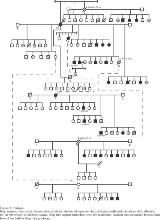BENIGN FAMILIAL PARTIAL EPILEPSY IN POODLES: NATURALLY OCCURRING ANIMAL MODEL
Abstract number :
2.116
Submission category :
Year :
2003
Submission ID :
2239
Source :
www.aesnet.org
Presentation date :
12/6/2003 12:00:00 AM
Published date :
Dec 1, 2003, 06:00 AM
Authors :
Barbara Licht, Linda Hyson, Shili Lin, Yuqun Luo, Soledad Fernandez, Mark Licht, Kathleen Harper Psychology, Florida State University, Tallahassee, FL; Statistics, Ohio State University, Columbus, OH; Center for Biostatistics, Ohio State University, Colum
The goal is to describe a new naturally occurring animal model of idiopathic partial epilepsy. We describe the phenotype and mode of inheritance for partial onset seizures in a large family of standard poodles with 30 affected and 60 unaffected dogs.
Owners of poodles with idiopathic epilepsy were recruited through breed clubs and the Internet. When multiple affected dogs from the same family were identified, breeders provided contact information for owners of related dogs. Owners were contacted to determine if their dog ever had seizures. Seizure descriptions given by owners were classified according to a modified (for dogs) version [1] of the International League Against Epilepsy seizure classification system.
To determine the mode of inheritance, the pedigree (Figure 1) was analyzed using formal segregation analysis. Six classes of one-locus models were considered: environmental; dominant and recessive (allowing for phenocopy and incomplete penetrance); simple dominant and simple recessive (allowing for incomplete penetrance); and complex. Within each class of models, the Expectation-Maximization (EM) algorithm with a Markov chain Monte Carlo (MCMC) procedure for facilitating the E-step was employed to obtain the maximum likelihood estimates of the parameters. The likelihoods of the resulted [quot]best[quot] models from the six classes were then compared using the likelihood ratio tests to select the overall best model for explaining the data observed.
[underline]Phenotype[/underline]: Epilepsy was benign; dogs took low doses or no anticonvulsants. Almost all seizures were classified as partial-onset. Motor signs were consistently reported; autonomic signs were reported to a lesser degree. Roughly 25% of the dogs had seizures that secondarily generalized to tonic-clonic or clonic. Clinical seizures were similar to those of humans.
[underline]Mode of Inheritance[/underline]: Analyses show that the best model is simple recessive with complete or almost complete penetrance and a gene frequency of 0.39. All tests were performed at the 5% significance level.
Naturally occurring idiopathic epilepsy in standard poodles may provide a new animal model of inherited benign partial-onset seizures, some of which secondarily generalize. The simple recessive mode of inheritance with high penetrance suggests that mapping studies can be successful.
[1] Licht B, Licht M, Harper K, Lin S, Curtin J, Hyson L, Willard K. Clinical presentations of naturally occurring canine seizures: Similarities to human seizures. Epilepsy Behav 2002;3:460-70[figure1]
[Supported by: Poodle Club of America, American Kennel Club CHF, Albrecht/FSU Epilepsy Fund, Versatility in Poodles.]
